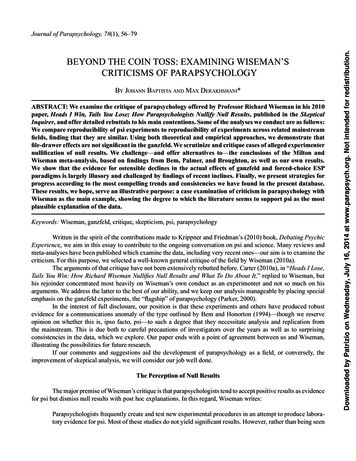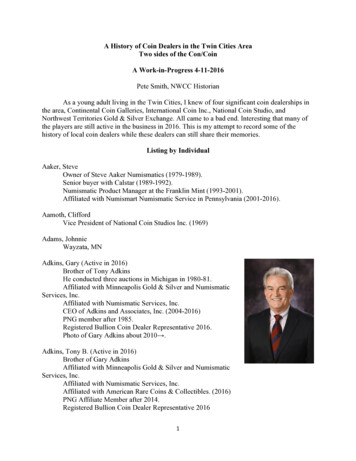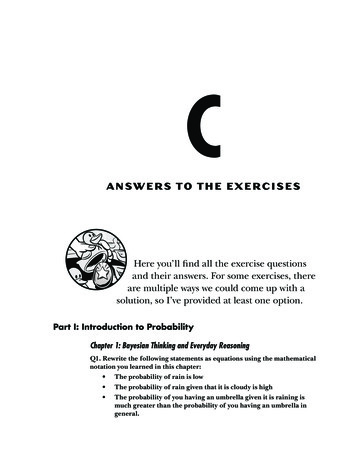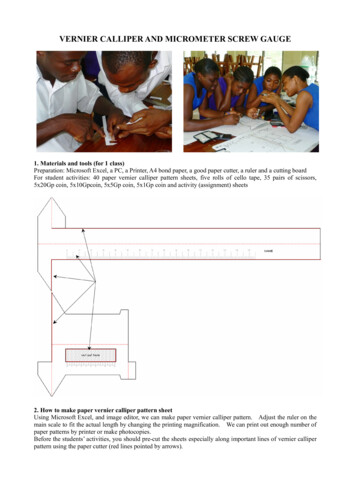
Transcription
BEYOND THE COIN TOSS: EXAMINING WISEMAN’SCRITICISMS OF PARAPSYCHOLOGYBy Johann Baptista and Max Derakhshani*ABSTRACT: We examine the critique of parapsychology offered by Professor Richard Wiseman in his 2010paper, Heads I Win, Tails You Lose; How Parapsychologists Nullify Null Results, published in the SkepticalInquirer, and offer detailed rebuttals to his main contentions. Some of the analyses we conduct are as follows:We compare reproducibility of psi experiments to reproducibility of experiments across related mainstreamfields, finding that they are similar. Using both theoretical and empirical approaches, we demonstrate thatfile-drawer effects are not significant in the ganzfeld. We scrutinize and critique cases of alleged experimenternullification of null results. We challenge—and offer alternatives to—the conclusions of the Milton andWiseman meta-analysis, based on findings from Bem, Palmer, and Broughton, as well as our own results.We show that the evidence for ostensible declines in the actual effects of ganzfeld and forced-choice ESPparadigms is largely illusory and challenged by findings of recent inclines. Finally, we present strategies forprogress according to the most compelling trends and consistencies we have found in the present database.These results, we hope, serve an illustrative purpose: a case examination of criticism in parapsychology withWiseman as the main example, showing the degree to which the literature seems to support psi as the mostplausible explanation of the data.Keywords: Wiseman, ganzfeld, critique, skepticism, psi, parapsychologyWritten in the spirit of the contributions made to Krippner and Friedman’s (2010) book, Debating PsychicExperience, we aim in this essay to contribute to the ongoing conversation on psi and science. Many reviews andmeta-analyses have been published which examine the data, including very recent ones—our aim is to examine thecriticism. For this purpose, we selected a well-known general critique of the field by Wiseman (2010a).The arguments of that critique have not been extensively rebutted before. Carter (2010a), in “Heads I Lose,Tails You Win: How Richard Wiseman Nullifies Null Results and What To Do About It,” replied to Wiseman, buthis rejoinder concentrated most heavily on Wiseman’s own conduct as an experimenter and not so much on hisarguments. We address the latter to the best of our ability, and we keep our analysis manageable by placing specialemphasis on the ganzfeld experiments, the “flagship” of parapsychology (Parker, 2000).In the interest of full disclosure, our position is that these experiments and others have produced robustevidence for a communications anomaly of the type outlined by Bem and Honorton (1994)—though we reserveopinion on whether this is, ipso facto, psi—to such a degree that they necessitate analysis and replication fromthe mainstream. This is due both to careful precautions of investigators over the years as well as to surprisingconsistencies in the data, which we explore. Our paper ends with a point of agreement between us and Wiseman,illustrating the possibilities for future research.If our comments and suggestions aid the development of parapsychology as a field, or conversely, theimprovement of skeptical analysis, we will consider our job well done.The Perception of Null ResultsThe major premise of Wiseman’s critique is that parapsychologists tend to accept positive results as evidencefor psi but dismiss null results with post hoc explanations. In this regard, Wiseman writes:Parapsychologists frequently create and test new experimental procedures in an attempt to produce laboratory evidence for psi. Most of these studies do not yield significant results. However, rather than being seenDownloaded by Patrizio on Wednesday, July 16, 2014 at www.parapsych.org. Not intended for redistribution.Journal of Parapsychology, 78(1), 56–79
Beyond the Coin Toss57Crucial to the strength of Wiseman’s critique is the question of how much weight null results shouldreasonably carry in the assessment of the evidence for psi—and what kind of null results are at issue. But before weaddress this, we note that although it is true that most studies in parapsychology databases do not display significantresults, it is also true that the number that do is significantly above the null hypothesis expectation. Consider, forexample, the post-PRL database, which consists of the studies in the Milton and Wiseman (1999) and Storm,Tressoldi, and Di Risio (2010) meta-analyses, covering the period 1988–2008. These 60 studies were conductedfollowing a seminal report from Honorton’s Psychophysical Research Laboratories (PRL; Bem & Honorton, 1994),after the strict methodological guidelines proposed by Hyman and Honorton (1986). Only 15 of these post-PRLstudies (25%) were significant at p .05, whereas under the null, only 5% should have met this threshold, and theprobability of getting 15 or more significant studies by chance alone is less than 1 in 5,200,000. Thus, averageinvestigators have a probability of producing significant results that is five times what they would have if nothingsignificant was occurring in these experiments. We consider that important. Indeed, it is on this sort of observationthat the ganzfeld, and similar domains of research, rest their claim to repeatability.But is it sufficient? We note that there are several valid metrics by which to gauge reproducibility, and it isbeyond the scope of this paper to present them all (see Cumming, 2012; Utts, 1991). The metric we focus on is theproportion of significant studies (p .05) produced by a given research technique, a result governed by statisticalpower, or 1-β. This can be thought of as the probability of obtaining significance given the attributes of one’sresearch methodology, and it is a direct function of type of significance test, effect size (ES), sample size (N), andalpha (α) level. Because power governs the potential success of a study, we believe it critical to consider powerbefore judging what level of reproducibility one should be seeing in a field as a litmus test of validity; after all, whenpower is low, we will fail to detect even a completely consistent effect more often than not.In this vein, it is reasonable to ask how much power is employed in parapsychology, generally. Accordingto Utts (1991) and Tressoldi (2012), not a lot. Taking the ganzfeld as a prototypical example, for the 105 studiesreported in Storm, Tressoldi, and Di Risio (2010) with four-choice designs, the overall hit rate is 32.2% and themean sample size is 42, for an average power per study of about 30%; this value comes close to the proportionof significant studies (28.5%) in that sample. Similar calculations performed by Derakhshani (2014)—using hisown power test and one recommended by Ioannidis and Trikalinos (2007)—demonstrate that the proportion ofsignificant studies in all past ganzfeld databases can be accurately predicted using standard power assumptions,within 95% confidence intervals. This suggests that ganzfeld studies elicit the level of consistency that is expectedgiven the characteristics of those studies, and that they are replicable insofar as we can make predictions about theirprobability of success and have them verified. The evidence is that psi effects, at least in the ganzfeld, lawfullyfollow the predictions of conventional statistical models to a degree that is conducive to scientific investigation.We should thus be able to reliably effect changes in our levels of success, using these models. If we aim for80% power in the ganzfeld, for example, we may try increasing sample size alone; however, this will result in atleast 236 needed trials (given the 32.2% hit rate found in Storm et al., 2010)—a quantity likely to be inaccessibleto the average investigator. In fact, the largest number of trials ever run in a single ganzfeld study is 138 (Parra &Villanueva, 2006). Another option to boost power is to raise the ES of studies. Derakhshani (2014) takes this routeand shows, based on the post-PRL database, that if investigators use only selected participants (e.g., participantswith prior psi experience, mental discipline practice, prior psi training, belief in psi, or preferably a combination ofthese)—a population that achieved a 40.1% hit rate in the post-PRL database—they would need only 56 trials for80% power. We note that this predicted higher proportion of significant studies is not only completely consistentwith past findings, but practicably attainable.Another question we might ask about power and replication in parapsychology is how they stack up withwhat is found in other sciences. To our knowledge, there has never been an in-depth comparison of this type, but oneis sorely needed. For example, in Richard, Bond, and Stokes-Zoota’s (2003) exhaustive meta-analysis of 322 metaanalyses in social psychology, the average statistical power was 20%, a little below that of the post-PRL database.With this power, the typical social science experiment would need at least 173 trials to achieve 80% reproducibility(at p .05), which is already considerably higher than normal (Hartshorne & Schachner, 2012). The reason for thisis that ESs in social psychology are usually small—about r .21 on average—and researchers tend not to conductDownloaded by Patrizio on Wednesday, July 16, 2014 at www.parapsych.org. Not intended for redistribution.as evidence against the existence of psychic ability, such null findings are usually attributed to the experiment being carried out under conditions that are not psi-conducive. (Wiseman, 2010a, p. 37)
The Journal of Parapsychologylarge enough studies to compensate for this. In fact, almost a third of the ESs reported in Richard et al. (2003) werer .1 or below, requiring an average N of 772 just to achieve a power of 80% (Hartshorne & Schachner, 2012).Hartshorne and Schachner (2012) write, additionally, thataccording to multiple meta-analyses, the statistical power of a typical psychology or neuroscience studyto detect a medium-sized effect (defined variously as r .3, r .4, or d .5) is approximately .5 or below(Bezeau & Graves, 2001; Cohen, 1962; Kosciulek & Szymanski, 1993; Sedlmeier & Gigerenzer, 1989).(p. 2)But in fact, for small effects (d 3), this power is much lower. Rossi (1990) observed a mean power of 17%across 221 articles for ESs in this range, in three prominent psychology journals starting in 1982. Neuroscienceresearch has also been recently reviewed by Button et al. (2013), who looked at 730 studies in 49 meta-analyses andconcluded that the median statistical power for that discipline was about 21%. They subsequently observed that theremoval of seven outlying meta-analyses with very large effect sizes brought their power estimate to 18%. All ofthese power values—from the average power in social psychology, the mean power for small effects in psychology,and the median power for neuroscience studies—fail to meet the average power for a ganzfeld study conservativelycalculated at 30%, for all 105 studies in Storm et al. (2010). Considering just the recently gathered 30 ganzfeld studies from 1997 to 2008 (Storm et al., 2010), the average power is actually much higher, at approximately 43%. Evenfor all the nonganzfeld free-response studies reported during that period in Storm et al. (2010), the mean power of19% (excluding four studies not of four-choice design) is still marginally greater than for most of the aforementioned mainstream areas.Bakker, Van Dijik, and Wicherts (2012) estimate, moreover, that for the average ES of psychology research(d 0.5, which they note is skewed by publication bias), using a two independent samples comparison, the powerof psychology studies across multiple meta-analyses is about 35% (p. 544). Despite the roughness of this estimate,it happens to closely match the reported current proportion of significant results in the Reproducibility Project database (33.3%), a meta-experiment with a median power of 95% to detect effects across a wide range of replicationsof papers representatively sampled from psychology journals (Nosek, Lai, LeBel, Gilbert, & Strohminger, 2014).Why are these percentages so similar? The answer is that publication bias in psychology is very prevalent, so thatif we assume a simplified model reasonably close to the truth, all published psychology studies are significant. Forpsychology studies with true effects, then, following Derakhshani (2014) and Ioannidis and Trikalinos (2007), ourmean power estimate says that 35% will reach significance and get published. Therefore 35% should very roughlybe the proportion of significant published studies with true effects. The other 65% should be false positives drawnfrom studies with no true effects. So when experiments such as those in the Reproducibility Project, using extremelyhigh power, representatively replicate from all published significant studies, those 35% of studies with true effectsshould be the studies that are successfully replicated. Since this seems to be the case, it confirms the predictionsof Derakhshani (2014) and Ioannidis and Trikalinos (2007) that, in the presence of a consistent effect, the averagepower in a field should serve as a good quantifier of reproducibility, per our definition.On this subject, Nosek (2012) writes:There exists very little evidence to provide reproducibility estimates for scientific fields, though someempirically informed estimates are disquieting (Ioannidis, 2005). When independent researchers tried toreplicate dozens of important studies on cancer, women’s health, and cardiovascular disease, only 25% oftheir replication studies confirmed the original result (Prinz, Schlange, & Asadullah, 2011). In a similarinvestigation, Begley and Ellis (2012) reported a meager 11% replication rate. (p. 657)In the face of these reproducibility estimates, we argue that for any area of parapsychology to achieve areplication rate of 25% to 30% to 37%—the proportion of significant results in the post-PRL, the whole ganzfeld,and the most recent 30 studies, respectively (Storm et al., 2010)—which we have shown to be comparable to othersciences; is in fact quite remarkable, given that the total human and financial resources devoted to psi research from1882 to 1993 has been estimated to comprise less than two months’ research in conventional psychology (Schouten,1993, p. 316). This observation warrants the conclusion that not only is the ganzfeld technique consistent, but it isalso progressing at a rate similar to that of mainstream social and behavioral fields—and surprisingly so, given itsDownloaded by Patrizio on Wednesday, July 16, 2014 at www.parapsych.org. Not intended for redistribution.58
59resources. The conformance of the ganzfeld database to power predictions, moreover, strongly suggests that adoption of strategies to boost power would improve reproducibility, and that attempting to do so would be a worthwhileventure.Investigating the File DrawerFor a meta-analysis to be valid, arguably the most important criterion is that all of the data are there toanalyze—or at least that no systematic bias of any importance is present in the studies selected. Yet this is whatWiseman (2010a) seems to imply by his comments:Once in a while one of these [parapsychology] studies produces significant results. Such studies frequentlycontain potential methodological artifacts, in part because they are using new procedures that have yet to bescrutinized by the research community . the evidential status of these positive findings is problematic tojudge because they have emerged from a mass of nonsignificant studies. Nevertheless, they are more likelythan nonsignificant studies to be presented at a conference or published in a journal. (p. 37)Firstly, it is important to note that the idea that positive studies are more likely to contain methodologicalartifacts is poorly supported for research into ESP (though it does receive some support for recent research intopsychokinesis, as seen below). We are aware of one meta-analysis by Schmidt, Schneider, Utts, and Walach (2004)that found a significant negative correlation between overall quality and ES for direct mental interaction with livingsystems (DMILS) studies, but not remote staring studies. These correlations are rare. Storm et al. (2010) showed,for example, that for their free response studies conducted from 1992–2008, quality ratings obtained under blindconditions did not correlate significantly with ESs: r(65) .08, p .11. We were further able to demonstrate thatfor groups of high-scoring selected participants in Storm et al.’s (2010) 30-study ganzfeld database, the meanstudy quality rating was greater than for the significantly lower-scoring unselected participants (q 0.84 and 0.79,respectively, where q 1.00 was the highest possible rating). We give a sampling of the literature on the question ofquality-ES correlations as follows, endeavoring to use only the most recent results for each paradigm of research:1. The only meta-analysis of physiological presentiment studies conducted to date detected a nonsignificantpositive correlation between methodological stringency and ES: r .21, 95% CI –.20–.53 (Mossbridge,Tressoldi, & Utts, 2012).2. A meta-analysis of forced-choice precognition studies yielded a very small and nonsignificant positivecorrelation between ES and study quality; r .08, p .20, two-tailed (Honorton & Ferrari, 1989).3. In a review of the success of the forced-choice ESP paradigm in parapsychology, a very small andnonsignificant negative relationship was found between ES and quality ratings, and thus no dependency; r -.08, p .48, two-tailed (Storm, Tressoldi, & Di Risio, 2012).4. Bösch et al. (2006) found a highly significant correlation between ES and safeguard sum score in theirdatabase of RNG studies, indicating that lower quality studies produced larger ESs: r(386) .15, p .004.They noted, however, that the average quality of these studies was very high.In view of these considerations, the hypothesis that experimental flaws are systematically and inverselyrelated to study ES in parapsychology should be seen as generally unsupported by the evidence, unless analysesusing novel quality ratings find conflicting results.Wiseman’s main criticism, however, raises a concern that parapsychologists have been conscious of for decades: the file-drawer problem. Its premise is that studies with positive results are more likely to find their way intometa-analytic databases than studies with negative results, and that this therefore creates a systematically biasedsample. This effect has been well-documented (Ahmed, Sutton, & Riley, 2012; Fanelli, 2010; Rothstein, Sutton,& Bornstein, 2005). Fanelli (2010), for example, observed that 84% of publications in various sciences reportedpositive results—a very unlikely proportion given the low power estimates discussed in the previous section ofDownloaded by Patrizio on Wednesday, July 16, 2014 at www.parapsych.org. Not intended for redistribution.Beyond the Coin Toss
The Journal of Parapsychologythis paper—with psychology reporting the most: 91.5%. This estimate for psychology is only minimally differentfrom previous values reported by Sterling (1959) and Sterling, Rosenbaum, and Weinkam (1995), at 97% and 96%respectively. It is common practice for journals to reject null studies in favor of positive ones—the result being thatmany unsuccessful studies never make it to publication, and thus escape detection by meta-analysts. Even if a studydoes get into print, it may still be excluded from meta-analytic consideration; biases inherent in the meta-analyticsearch process or inclusion criteria may cause the study either to be overlooked or disregarded. We make a distinction between these two types of selection bias, calling the first publication bias and the second inclusion bias(although both are problematic, the former is arguably more so, as unpublished studies are less likely to be foundthan published studies).Based on these reasons, then, we note that the selection bias criticism is a priori an extremely powerful one,but as we hope to show for parapsychology, ultimately untenable. One reason is that awareness of the filedrawercame early for psi researchers. The earliest systematic cross-laboratories meta-analysis in scientific history, reportedin Extra-Sensory Perception After Sixty Years (Rhine, Pratt, Stuart, Smith, & Greenwood, 1967), included a statistical method to estimate the influence of publication bias. Additionally, in 1975, the Parapsychological Association(PA) became the first scientific organization to adopt an official policy of publishing null results (Carter, 2010a).Beyond explicitly minimizing the file drawer, this decision brought into common psi research practice techniquesdesigned to measure study selection bias, such as funnel plots, Rosenthal’s fail-safe N, and trim-and-fill methods, allof which have been used in reviews of psi research to argue effectively against the file-drawer explanation.With regard to the ganzfeld, for example, Storm et al. (2010) applied Rosenthal’s fail-safe N (Harris &Rosenthal, 1985, p. 189) and found that no fewer than 2,414 unpublished studies with overall null results (i.e.,z 0) would have to exist to reduce their 108 ganzfeld study database to nonsignificance. This is not a likelyscenario. However, some have argued that Rosenthal’s calculation overestimates the file drawer (Scargle, 2000)by definition, because it implicitly assumes the reservoir of unpublished studies to be unbiased (z 0) insteadof directionally negative (z 0). To overcome this problem, there are more conservative procedures such as theDarlington and Hayes (2003) method, which allows for a large proportion of unpublished studies to have negativez scores. Applying this method as an additional check for the same homogeneous 102-study database, Storm et al.(2010) showed that the number of unpublished studies necessary to nullify just their 27 studies with statisticallysignificant positive outcomes was 384, and 357 of these could have z 0. Given the official policy of publishing nullresults set down by the PA, and the small number of scientists conducting research in this area, such a large numberof negative studies can only be deemed highly untenable.With regard to the validity of Rosenthal’s fail-safe N, we agree with the technical correction put forwardby Scargle (2000) that the theoretical mean z of unpublished studies for an extreme file-drawer case, under anull distribution, is -0.1085, not 0. Harris and Rosenthal (1988) note, however, that “Based on experience withmeta-analyses in other domains of research (e.g., interpersonal expectancy effects) the mean z or effect size fornonsignificant studies is not zero but a value pulled strongly from zero toward the mean z or mean effect size ofthe obtained studies (Rosenthal & Rubin, 1978)” (p. 45). Their assumption that the average z score of excludedstudies is zero is therefore a conservative one for most any distribution that is shifted some positive distance froma null distribution, and although this specifically indicates situations where an effect is present, we argue that theevidence for such an effect in the ESP literature is overwhelming, whatever one may believe about its underlyingcause. Another conservative assumption in Rosenthal’s procedure is that each excluded study is considered to havea sample size equal to the average sample size of the meta-analysis, whereas overlooked studies tend to be smaller.Further evidence against the file-drawer effect in the ganzfeld, supporting the notion that unpublished studies show directionally positive results, comes from a mail survey by Blackmore (1980), who queried parapsychologists conducting ganzfeld experiments to obtain a direct estimate of the file drawer. The returned questionnairesrevealed 32 unreported studies, 12 of which were still in progress, and one that could not be analyzed. Of the 19remaining, 14 were judged to have adequate methodology, including 5 that were significant (36% of the total). Thisproportion of significant results is statistically unlikely according to the null hypothesis; in fact, it yields an exactbinomial result of p .0004, or odds against chance of 2,342 to 1. So the file drawer itself is—directly counter tothe skeptical prediction—inclined towards the psi hypothesis. Furthermore, the proportion of significant studies inBlackmore’s 1980 paper (5 out of 14, or 36%) is not significantly different from the proportion found in Honorton’s1985 meta-analysis (12 out of 28, or 43%), Fisher’s exact p .46, one tailed. Given this information, it is not surprising that Blackmore (1980) concluded that “the bias introduced by selective reporting of ESP ganzfeld studies isDownloaded by Patrizio on Wednesday, July 16, 2014 at www.parapsych.org. Not intended for redistribution.60
61not a major contributor to the overall proportion of significant results” (p. 217). Blackmore’s survey must be understood in context, however; it took place more than 34 years ago, and 20 studies in it were destined for publication.As such, it can only be considered a snapshot of the file drawer at a given time.Additionally, even if one entertains the notion that the included ganzfeld studies are drawn from an overallstatistically null distribution—in spite of the results of the conservative Darlington-Hayes calculation and theBlackmore (1980) survey—the parapsychological practice of considering significantly negative results to be “psimissing,” and therefore potential evidence for psi, helps to ensure that the negative tail of this distribution is alsoincluded, meaning that the average z of the excluded studies should be relatively close to zero, not highly negative.This symmetrical exclusion principle is supported by Harris and Rosenthal’s (1988) assessment of the ganzfeld,which yielded evidence consistent with “larger positive and larger negative effect sizes than would be reasonable”(Harris & Rosenthal, 1980, p. 44), although by a small margin.Perhaps most persuasively, as we showed in the first section of this paper, the average power of ganzfeldstudies across databases accurately predicts their proportion of significant results, suggesting minimal or no selectionbias (Ioannidis & Trikalinos, 2007). Similar calculations to Rosenthal’s and Darlington and Hayes’, as well asfunnel plots and trim and fill algorithms, have plausibly written the file-drawer explanation out of other paradigmsin parapsychology, including remote viewing studies (Tressoldi, 2011), psychokinesis studies (Radin et al., 2006),forced-choice ESP studies (Tressoldi, 2011), and precognition studies (Honorton & Ferrari, 1989). Collectively,they provide evidence that selective reporting is not a significant factor in psi research.There is, however, a still more direct way to tackle Wiseman’s (2010a) criticism, since in his words “. onlyone paper has revealed an insight into the potential scale of [the file-drawer] problem”(p. 37). That paper is the Watt(2007) Koestler Parapsychology Unit report, which surveyed all parapsychology undergraduate projects undertakenand supervised by the Edinburgh staff between 1987 and 2007. About it, Wiseman (2010a) says:Only seven of the 38 studies had made it into the public domain, presented as papers at conferences heldby the Parapsychological Association . there was a strong tendency for parapsychologists to make publicthose studies that had obtained positive findings, with just over 70 percent (five out of seven) of the studiespresented at conferences showing an overall significant result, versus just 15% (3 out of 20) of those thatremained unreported. (p. 37)At first glance, this appears to be incontestable proof of a serious publication bias, but a closer look at whatWiseman says is instructive. First, the very fact that meta-analyses in parapsychology include studies presented atconferences but not published in journals (an uncommon practice in the sciences) testifies to its attempt to combatselective reporting (note that PA conference papers are still peer reviewed). Second, Wiseman makes a critical mistake when he mixes projects as varied as “dowsing for a hidden penny, the psychokinetic control of a visual displayof a balloon being driven by a fan onto spikes, presentiment of photographs depicting emotional facial expressions,detecting the emotional state of a sender in a telepathy experiment, ganzfeld studies, and card guessing” (p. 37) andthen gives the inflated 70% and 15% figures as evidence for a massive file-drawer effect. Because these studies fallinto different experimental paradigms, and some of them do not belong clearly to any defined line of research (i.e.,they are purely exploratory), mixing them together tells us nothing about the evidential impact of this file draweron proof-oriented meta-analyses.It can be seen, for example, that if just one type of study is taken from Edinburgh’s varied selection—ganzfeld studies—Wiseman’s criticism is rendered moot. Of the 38 KPU undergraduate projects that tested fora psi effect, only 5 were ganzfeld (one by Colyer and Morris, cited by Watt, 2006; one by Morris, Cunningham,McAlpine, and Taylor, 1993; two by Morris, Summers, and Yim, 2003; and one by Symmons and Morris, 1997).Furthermore, although the nonsignificant Colyer and Morris study was the only study not presented at PA conventions, the Morris et al. (1993) study was presented, and was also nonsignificant. This leaves a single study in thefile drawer whose reasons for not being included are unknown, and whose exclusion is not enough to say anythingmeaningful about selective reporting in the ganzfeld.Putting aside ganzfeld studies, three additional student projects were presented at the PA conventions, andthey were all DMILS studies. Two had significant resul
These results, we hope, serve an illustrative purpose: a case examination of criticism in parapsychology with Wiseman as the main example, showing the degree to which the literature seems to support psi as the most plausible explanation of the data. Keywords: Wiseman, ganzfeld, critique, skepticism, psi, parapsychology










